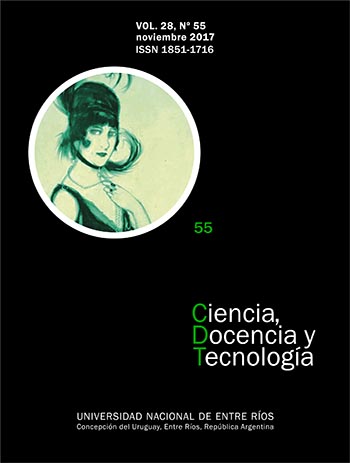Abstract
This article aims to propose the use of a mathematical function to prioritize groups to intervene. We present the mathematical properties of the so-called prioritization function, ensuring injectivity and consistency. The application of the function is simulated to a particular case that considers 9 courses in an educational establishment, where it is necessary to decide on which to apply a sexual education plan. It is concluded that the Function is applicable, although it is not the solution to the decision problem, if it opens a way to the objectification of the decisions. It allows enriching quantitative diagnoses and avoiding the discretion of prioritization criteria, which obviously translates into optimization of interventions and therefore of economic resources.
References
BEASLEY, T.; SCHUMACKER, R. (1995). Multiple regression approach to analyzing contingency tables: post hoc and planned comparison procedures. The Journal of Experimental Education, 64(1):79-93. Disponible en: <https://www.researchgate.net/profile/Timothy_Beasley/publication/254346745_Multiple_Regression_Approach_to_Analyzing_Contingency_Tables_Post_Hoc_and_Planned_Comparison_Procedures/links/5485f3960cf289302e2abade.pdf> [10 de diciembre de 2015].
BERGMAN, L.R.; EL-KHOURI, B. Exacon: A fortran 77 program for the exact analysis of single cells in a contingency table. Educational and Psychological measurement. 1987;47(1):155-161. Disponible en:<http://epm.sagepub.com/content/47/1/155.short > [10 de diciembre de 2015].
GÁNDARA, G. (2006). La metodología cuantitativa de investigación social como herramienta para la definición, diseño, implementación y evaluación de las políticas sociales. Observatorio Social, (15):4-8. Disponible en: <http://www.observatoriosocial.com.ar/images/pdf_revistas/revi_15.pdf >[8 de diciembre de 2015].
GIERL, M. (1997). Comparing cognitive representations of test developers and students on a mathematics test with bloom’s taxonomy. The Journal of Educational Research, 91(1):26-32. Disponible en: <http://www.tandfonline.com/doi/abs/10.1080/00220679709597517> [10 de diciembre de 2015].
HO, Y.; CHU, K. (1972). Team decision theory and information structures in optimal control problems. IEEE Transactions, 17(1):15-22. Disponible en: <http://ieeexplore.ieee.org/xpl/login.jsp?tp=&arnumber=1099850&url=http%3A%2F%2Fieeexplore.ieee.org%2Fxpls%2Fabs_all.jsp%3Farnumber%3D1099850> [10 de diciembre de 2015].
JOYCE, J. (1999). The foundations of causal decision theory. Cambridge: Cambridge University Press.
LI, H.; ZHOU, X. (2011). Risk decision making based on decision-theoretic rough set: a three-way view decision model. International Journal of Computational Intelligence Systems, 4(1):1-11. Disponible en: https://www.researchgate.net/profile/Huaxiong_Li/publication/241683926_Risk_Decision_Making_Based_on_Decision-theoretic_Rough_Set_A_Three-way_View_Decision_Model/links/0deec527865a2688f5000000.pdf > [10 de diciembre de 2015].
MELLENBERGH, G. (1982). Contingency table models for assessing item bias. Journal of Educational and Behavioral Statistics, 7(2):105- 118. Disponible en: <http://jeb.sagepub.com/content/7/2/105.short> [10 de diciembre de 2015].
ORTEGÓN, E.; PACHECO, J.C.; ROURA, H. (2005). Metodología general de identificación, preparación y evaluación de proyectos de inversión pública. Instituto Latinoamericano y del Caribe de Planificación Económica y Social (ILPES). Serie Manuales, (39):9-27. Disponible en: <http://repositorio.cepal.org/bitstream/handle/11362/5608/S056394_es.pdf?sequence=1> [9 de Diciembre de 2015].
REBOLLOSO, E. (2008). Evaluación de programas de intervención social. Madrid: Editorial Síntesis S.A.
SEARS, D.; PAI, H. (2012) Effects of cooperative versus individual study on learning and motivation after reward-removal. The Journal of Experimental Education, 80(3):246-262. Disponible en: <http://www.tandfonline.com/doi/abs/10.1080/00220973.2011.602372#.VmmZ9krhDIU > [10 de diciembre de 2015].
SHAPIRO, J.; STEFKOVICH, J. (2001). Ethical leadership and decision making in education: Applying theoretical perspectives to complex dilemmas. Londres: Routledge.
SHAVELSON, R.; CADWELL, J.; IZU, T. (1977). Teachers’ sensitivity to the reliability of information in making pedagogical decisions. American Educational Research Journal,14(2):83-97. Disponible en: <http://aer.sagepub.com/content/14/2/83.short> [10 de diciembre de 2015].
SWEENY, K. (2008) Crisis decision theory: Decisions in the face of negative events. Psychological Bulletin, 134(1):61-76. Disponible en: <http://www.katesweeny.com/uploads/2/6/9/4/26944848/sweeny_2008_psychbull.pdf > [10 de diciembre de 2015].
TIERNEY, W. (2008). The impact of culture on organizational decision-making: Theory and practice in higher education. Virginia: Stylus Publishing, LLC.
WOLFMAN, G. (2006). Herramientas estadísticas en el diseño y evaluación de políticas públicas. El modelo lineal y el modelo lineal generalizado. Observatorio Social, (15):9-13. Disponible en: <http://www.observatoriosocial.com.ar/images/pdf_revistas/revi_15.pdf >[8 de diciembre de 2015].
WRIGHT, G. (1984). Behavioral decision theory: an introduction. Harmondsworth: Penguin Books.
The authors retain the copyright and grant the journal the right to be the first publication of the work, as well as licensing it under a Creative Commons Attribution License that allows others to share the work with an acknowledgment of the authorship of the work and publication initial in this magazine. All content is published under the Creative Commons 4.0 international license: Attribution-Non-Commercial-Share Alike.

